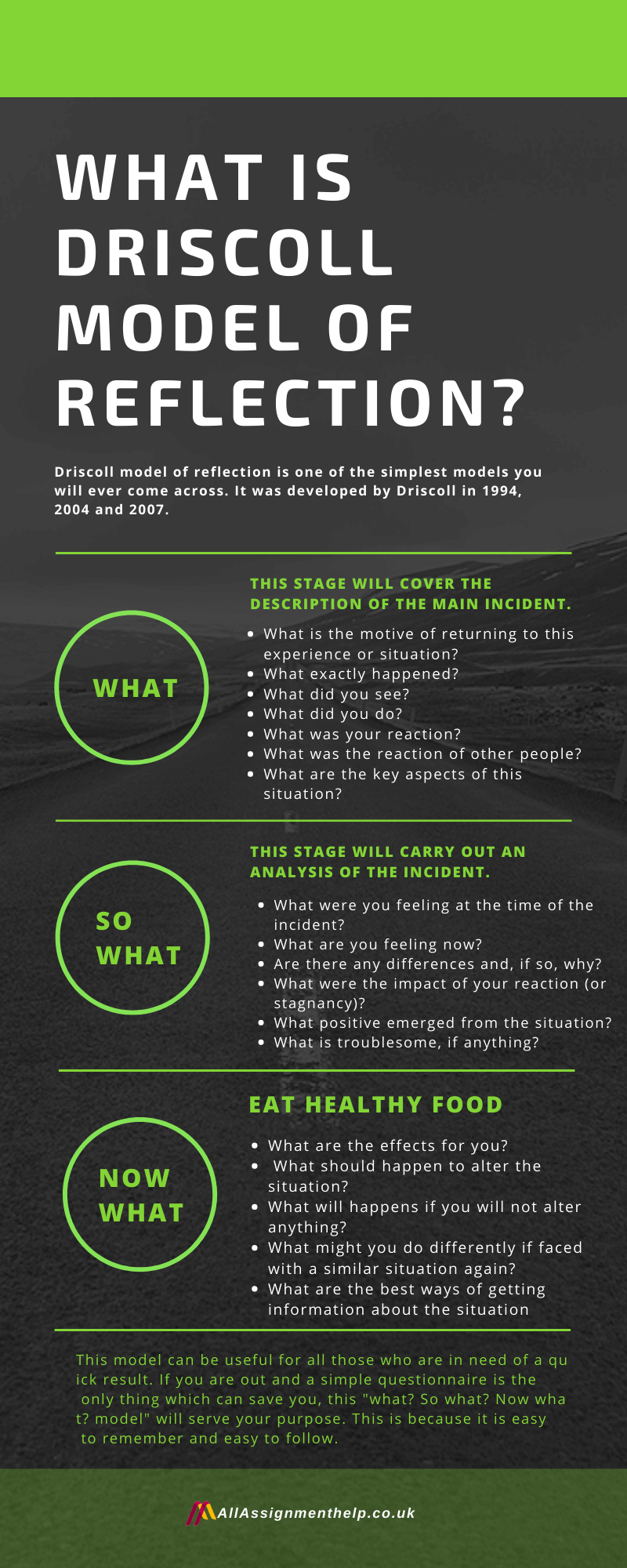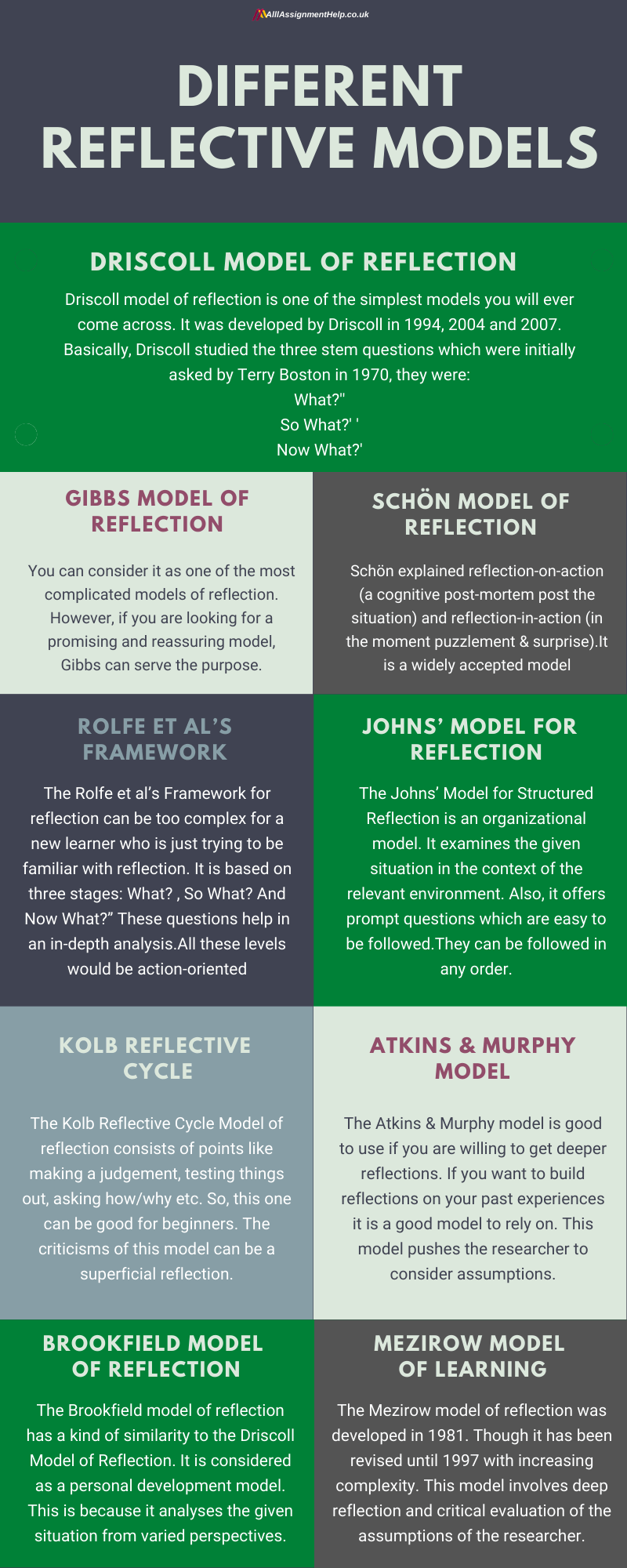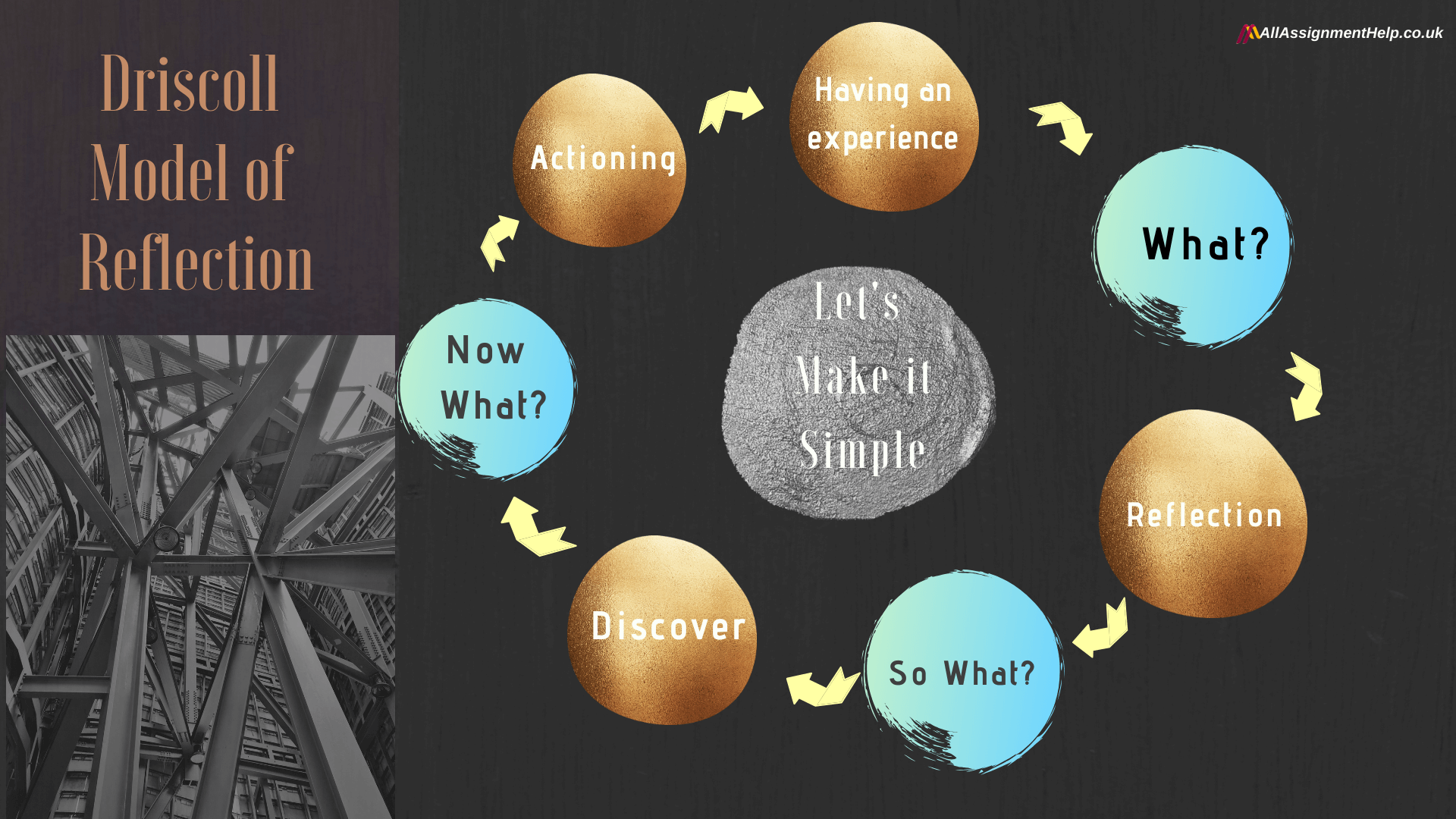Trying to know Driscoll model of reflection? If yes, then you have landed on the right page. We will share all the basics of “what, so what, now what model of reflection Driscoll 2007”.
What is Driscoll model of reflection?
Driscoll model of reflection is one of the simplest models you will ever come across. It was developed by Driscoll in 1994, 2004 and 2007. Basically, Driscoll studied the three stem questions which were initially asked by Terry Boston in 1970, they were:
- What?’
- ‘So What?’
- ‘Now What?’
He matched them to the stages of an experiential learning cycle. Also, he included trigger questions which are generally used to complete the cycle. Before moving to a detailed explanation of the model, let’ understand the Driscoll cycle.
Driscoll model of reflection cycle (Driscoll Cycle)
The best way to understand Driscoll Cycle is to study it through an example. So, here we are presenting an example of a nursing intern:
Suppose a nursing intern has to write a paramedic reflection related to a severe incident on a message she got from the family of her patient. Here is how her scattered pieces of thoughts would turn into a neat and clear reflection using Driscoll’s cycle.
Experience: A nursing intern faces a certain experience in clinical practice
WHAT?
This stage will cover the description of the main incident. It would reflect purposefully on a particular aspect of that experience through questions like:
- What is the motive of returning to this experience or situation?
- What exactly happened?
- What did you see?
- What did you do?
- What was your reaction?
- What was the reaction of other people?
- What are the key aspects of this situation?
SO WHAT?
This stage will carry out an analysis of the incident. Here the intern would discover the learning occurs from the process of reflection. Main questions which will arise here are:
- What were you feeling at the time of the incident?
- What are you feeling now?
- Are there any differences and, if so, why?
- What were the impact of your reaction (or stagnancy)?
- What positive emerged from the situation?
- What is troublesome, if anything?
- What were your experiences in comparison to others?
- What are the main reasons for feeling differently from other people?
NOW, WHAT?
This stage would show the proposed actions after the occurrence of the incident or experience. Actioning the new learning from that experience in clinical practice it raises questions like:
- What are the effects for you?
- What should happen to alter the situation?
- What are you planning to do in the situation?
- What will happens if you will not alter anything?
- What might you do differently if faced with a similar situation again?
- What is the required information do you need to face the same situation again?
- What are the best ways of getting information about the situation should it arise again?

How to use The Driscoll Model of Reflection?
When it comes to writing a reflection many students get confused, some ask for help with assignment online whereas some just sit idle with lots of confusion in their minds. However, it is very simple to prepare a reflection. All you need to do is to choose a suitable approach or model. Here, we will discuss how you can use “the what model of reflection Driscoll 2000”.
Initially, you will have to ask three simple and easy questions to yourself. Then you can start to analyze your experiences. This can be an enriching chance for you. First of all, you will have to explain the main incident, situation, experience or event which was to set it in context. This initial step is basic yet important as it will give you a clear picture of what you are going to deal with.
Moving on, you will then reflect on the main event, experience or situation by proposing a question: So What? – What will I learn as a result of this particular situation? After this, you will finally reach the last stage of the Driscoll’s Cycle, and here you need to think about the actions. These are supposed to be the actions you will take as an outcome of your reflection. Think about whether you will change behaviour? Or “Is there any need to bring some changes or is it okay to continue it as it is?”
It may happen that nothing changes as a result of your reflection. You may feel that everything that was supposed to be done in the given situation is actually being done. If you get such a neutral kind of result, don’t get confused. This is also a valid outcome. You don’t need to change something every time. Lastly, read as much as you can. Because you can get a broader idea by having a glance at Driscoll model references.
Advantages and Disadvantages of Driscoll Model
Thinking why one should use The Driscoll 2007 Model of Reflection? We have explained why it is favourable for some and unfavourable for others:
Driscoll model of reflection advantages
This model can be useful for all those who are in need of a quick result. If you are out and a simple questionnaire is the only thing which can save you, this “what? So what? Now what? model” will serve your purpose. This is because it is easy to remember and easy to follow. The queued questions are nowhere near to complications. Even assignment experts say that beginners can use this model of reflection with ease too.
Driscoll so what model of reflection disadvantages
The one and only criticism or disadvantage of Driscoll model of reflection is that it cannot provide you with a deeper reflection. So, if you are planning to prepare a layered or extensive reflection, this may not work for you.
By now we have read enough about the Driscoll model of reflection so let’s move to know the other models as well. It is always better to have a good understanding of these models. Majorly, there are nine of them including Driscoll model of reflection. Here is a list of all these models:
- Gibbs Model of Reflection (1988)
- Schön Model of Reflection (1991)
- Driscoll Model of Reflection
- Rolfe et al’s Framework for Reflexive Learning (2001)
- Johns’ Model for Structured Reflection (2006)
- Kolb reflective cycle (1984)
- Atkins & Murphy model [1993]
- Brookfield model (2005)
- Mezirow model of transformative learning [1981]
Different Reflective Models

Gibbs Model of Reflection (1988)
The Gibbs reflective cycle builds on the six stages. You can consider it as one of the most complicated models of reflection. However, if you are looking for a promising and reassuring model, Gibbs can serve the purpose. The six stages it contains are:
- Description
- Feelings
- Evaluation
- Analysis
- Conclusion
- Action plan
Just like other models of reflection, it starts with an outline of the main experience that is being reflected. This one encourages to focus on the feelings about the situation, event or experience. The next step includes an evaluation of the experience. You will have to think about what was bad or good about the whole thing from your perspective. You can use this evaluation, later on, to analyse the experience and make sense of it. The analysis would be backed by conclusions on what other actions could have been taken to make the situation or experience a little better. The final stage is all about building an action plan of steps which you can take if the same situation occurs again.
Schön Model of Reflection (1991)
Schön explained reflection-on-action (a cognitive post-mortem post the situation) and reflection-in-action (in the moment puzzlement & surprise). It is a professional model widely accepted by people. In recent years it has gained immense professional confidence and artistry. However, disadvantages also exist. The problem with this model of reflection is that it is limited to highlighting the difference between two types of reflection. It will not offer wider guidance for carrying out any of them with perfection.
Driscoll method of reflection
The Driscoll method of reflection has been already explained at the beginning of this blog post.
Rolfe et al’s Framework for Reflexive Learning (2001)
The Rolfe et al’s Framework for reflection can be too complex for a new learner who is just trying to be familiar with reflection. It is based on three stages: What? , So What? And Now What?” These questions help in an in-depth analysis. When you will repeat them at three levels you will get deeper reflection at every level. All these levels would be action-oriented, theoretical and descriptive. This model is purely based on the developmental model of Borton. The good thing is that working on these same questions at different levels can be helpful in development from novice to expert stage.
Johns’ Model for Structured Reflection (2006)
The Johns’ Model for Structured Reflection is an organizational model. It examines the given situation in the context of the relevant environment. Also, it offers prompt questions which are easy to be followed. They can be followed in any order. However, generally, they follow a natural progression. This model can be used by groups or individuals. It is based on the four types of knowing concept by Carper, they are personal, ethical, aesthetic and empirical. John added a fifth one in this list – reflexivity and came up this new model for structured reflection.
The major criticisms are as follows:
The prompt questions are not structured in a rigid manner and this can be confusing for beginners. It can be tricky to understand which one can be salient and which ones can be omitted for reflection. Also, it can be time-consuming.
The Kolb Reflective Cycle (1984)
The Kolb Reflective Cycle Model of reflection consists of points like making a judgement, testing things out, asking how/why etc. So, this one can be good for beginners. The criticisms of this model can be a superficial reflection. You can not get a referral to critical analysis/assumption/viewing or thinking. It does not contain the number of probing queries like the Driscoll model of reflection.
Atkins & Murphy model [1993]
The Atkins & Murphy model is good to use if you are willing to get deeper reflections. If you want to build reflections on your past experiences it is a good model to rely on. This model pushes the researcher to consider assumptions. The main criticisms of the Atkins & Murphy Model are that you may not find it useful when you need quick reflections. So, those who are in need of instant on-the-go reflections should try something else.
Brookfield model (2005)
The Brookfield model of reflection has a kind of similarity to the Driscoll Model of Reflection. It is considered as a personal development model. This is because it analyses the given situation from varied perspectives. It offers a deeper reflection which leads to peer assessment and information gleaned from academic literature and takes into account personal self-reflection. For all these reasons this one is highly recommended to a person who has enough motivation for self-directed learning. The points for criticism of this model also exist. It covers four different points of view at the same time. So, if you are planning to observe a specific area in an in-depth manner this may not be helpful to you.
Mezirow model of transformative learning [1981]
The Mezirow model of reflection was developed in 1981. Though it has been revised until 1997 with increasing complexity. This model involves deep reflection and critical evaluation of the assumptions of the researcher. It provides frames of reference from varied perspectives. Unlike the Driscoll model of reflection, here, the reflection is shallow. However, it progresses to reflection on-premise and reflection on the process. This is what leads to an in-depth reflection and ultimately personal development. It is highly suitable for those who are leaned towards self-directed learning. Mezirow explains that reflection is helpful only when it leads to a change in self or learning from a dilemma. The con of this model is that it does not focus on the emotional facet of a given situation. It focuses heavily on rational aspects.
